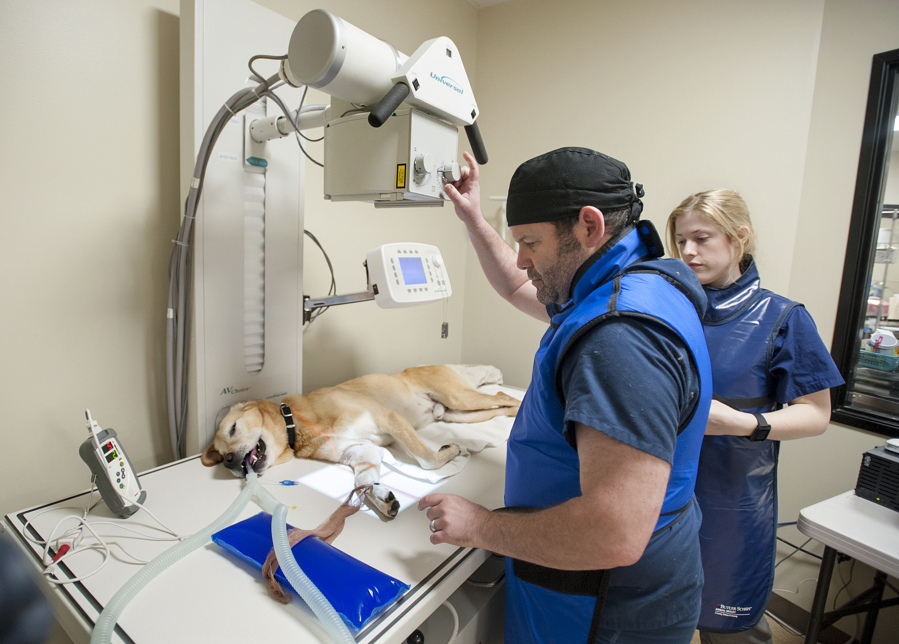When Duke, a yellow Labrador mix, was brought into the Humane Society for Southwest Washington as a stray, someone noticed that he was limping. In the past, it would have taken the east Vancouver animal shelter a few days to get the approximately 7-year-old dog to a veterinary clinic for an X-ray.
The clinic recently got radiology equipment, so Duke — who was under anesthesia — was placed onto the exam table Thursday afternoon. Within seconds a scan provided digital images of his leg bones. Duke’s results weren’t clear, but he appeared to have a bone shard near his elbow, said Dr. Kristi Ellis, lead veterinarian at the shelter. She’ll send Duke’s information to a specialist.
The new radiology equipment includes the body X-ray, a dental X-ray and a server for storing all of the images. Since getting the equipment six weeks ago, the shelter has X-rayed about 30 animals. Previously, the medical staff had to make an executive decision about whether an observed issue warranted a trip to a veterinary clinic.
“It’s been significantly more efficient to be able to deal with animals that have potentially life-threatening injuries or significant injuries that might be causing pain or suffering,” said Lisa Feder, vice president of operations. “It’s really hard for us to drop everything and take an animal to the emergency vet or to another vet just to get an X-ray.”
It was unusual that the shelter, given its size, didn’t have any radiology equipment; the Oregon Humane Society, for instance, has several X-ray machines, Feder said.
The ability to purchase the equipment was spurred by an unsolicited $30,000 grant from the Banfield Foundation, which was part of the nonprofit’s 12 Days of Giving campaign. The Banfield Foundation, established in September 2015, is a separate charitable arm of Banfield Pet Hospital, which recently moved its corporate headquarters to east Vancouver.
“Probably, we wouldn’t have the equipment without them,” said Denise Barr, the shelter’s marketing director.
Following Banfield’s gift, the Humane Society launched a three-month fundraising campaign. Twenty-five investor donors contributed the remaining $100,000 needed.
“At Banfield Pet Hospital and the Banfield Foundation, we believe in the importance of veterinary care for all pets — not just those who are owned,” Kim Koenig said in a statement. She’s the program manager for corporate social responsibility at the pet hospital. “Via our volunteer work, we have seen first-hand the care and work that goes in to caring for the pets at the Humane Society for Southwest Washington, and are proud to help them serve hundreds and thousands of pets in the years to come.”
In some cases, an X-ray diagnosis can be lifesaving.
A cat recently rescued at a busy intersection had apparently been hit by a car. She was in bad shape and was having trouble breathing.
“Without a diagnosis I don’t know what to treat,” Ellis said. “Once I knew what it was, then I could fix it.”
Within 30 minutes of her arrival, staff were able to X-ray the cat. It turned out she had a collapsed lung that Ellis drained, saving the cat’s life. If the cat had to wait to go to an outside veterinarian, she wouldn’t have made it, Ellis said. Eventually, the cat, Monkey, was reunited with its owners thanks to “lost cat” signs Ellis posted at the intersection where she was found.
Limping, vomiting and trouble breathing are each symptoms that would warrant using the radiology equipment. Often, people bring in stray animals that are injured or have skin issues or need dental work, Feder said.
The Humane Society feels responsible for placing animals up for adoption with a reasonable expectation of them being healthy, she said. The radiology equipment “will make a huge change in the quality of our shelter medicine program and a huge change in the quality of animals we put up for adoption,” Feder said.
The Humane Society already does other medical procedures include spaying and neutering animals, eye surgery, dental surgery and amputations. Currently, the save rate at the shelter is 97 percent for dogs and 92 percent for cats.




